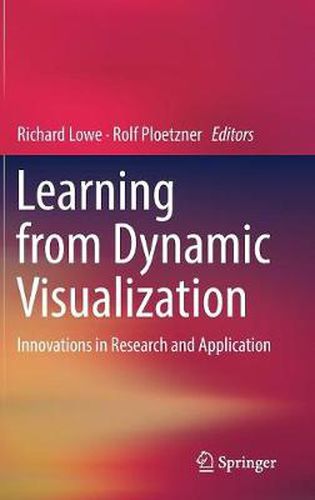Readings Newsletter
Become a Readings Member to make your shopping experience even easier.
Sign in or sign up for free!
You’re not far away from qualifying for FREE standard shipping within Australia
You’ve qualified for FREE standard shipping within Australia
The cart is loading…






This title is printed to order. This book may have been self-published. If so, we cannot guarantee the quality of the content. In the main most books will have gone through the editing process however some may not. We therefore suggest that you be aware of this before ordering this book. If in doubt check either the author or publisher’s details as we are unable to accept any returns unless they are faulty. Please contact us if you have any questions.
This volume tackles issues arising from today’s high reliance on learning from visualizations in general and dynamic visualizations in particular at all levels of education. It reflects recent changes in educational practice through which text no longer occupies its traditionally dominant role as the prime means of presenting to-be-learned information to learners. Specifically, the book targets the dynamic visual components of multimedia educational resources and singles out how they can influence learning in their own right. It aims to help bridge the increasing gap between pervasive adoption of dynamic visualizations in educational practice and our limited understanding of the role that these representations can play in learning.
The volume has recruited international leaders in the field to provide diverse perspectives on the dynamic visualizations and learning. It is the first comprehensive book on the topic that brings together contributions from both renowned researchers and expert practitioners. Rather than aiming to present a broad general overview of the field, it focuses on innovative work that is at the cutting edge.
As well as further developing and complementing existing approaches, the contributions emphasize fresh ideas that may challenge existing orthodoxies and point towards future directions for the field. They seek to stimulate further new developments in the design and use of dynamic visualizations for learning as well as the rigorous, systematic investigation of their educational effectiveness.
$9.00 standard shipping within Australia
FREE standard shipping within Australia for orders over $100.00
Express & International shipping calculated at checkout
This title is printed to order. This book may have been self-published. If so, we cannot guarantee the quality of the content. In the main most books will have gone through the editing process however some may not. We therefore suggest that you be aware of this before ordering this book. If in doubt check either the author or publisher’s details as we are unable to accept any returns unless they are faulty. Please contact us if you have any questions.
This volume tackles issues arising from today’s high reliance on learning from visualizations in general and dynamic visualizations in particular at all levels of education. It reflects recent changes in educational practice through which text no longer occupies its traditionally dominant role as the prime means of presenting to-be-learned information to learners. Specifically, the book targets the dynamic visual components of multimedia educational resources and singles out how they can influence learning in their own right. It aims to help bridge the increasing gap between pervasive adoption of dynamic visualizations in educational practice and our limited understanding of the role that these representations can play in learning.
The volume has recruited international leaders in the field to provide diverse perspectives on the dynamic visualizations and learning. It is the first comprehensive book on the topic that brings together contributions from both renowned researchers and expert practitioners. Rather than aiming to present a broad general overview of the field, it focuses on innovative work that is at the cutting edge.
As well as further developing and complementing existing approaches, the contributions emphasize fresh ideas that may challenge existing orthodoxies and point towards future directions for the field. They seek to stimulate further new developments in the design and use of dynamic visualizations for learning as well as the rigorous, systematic investigation of their educational effectiveness.